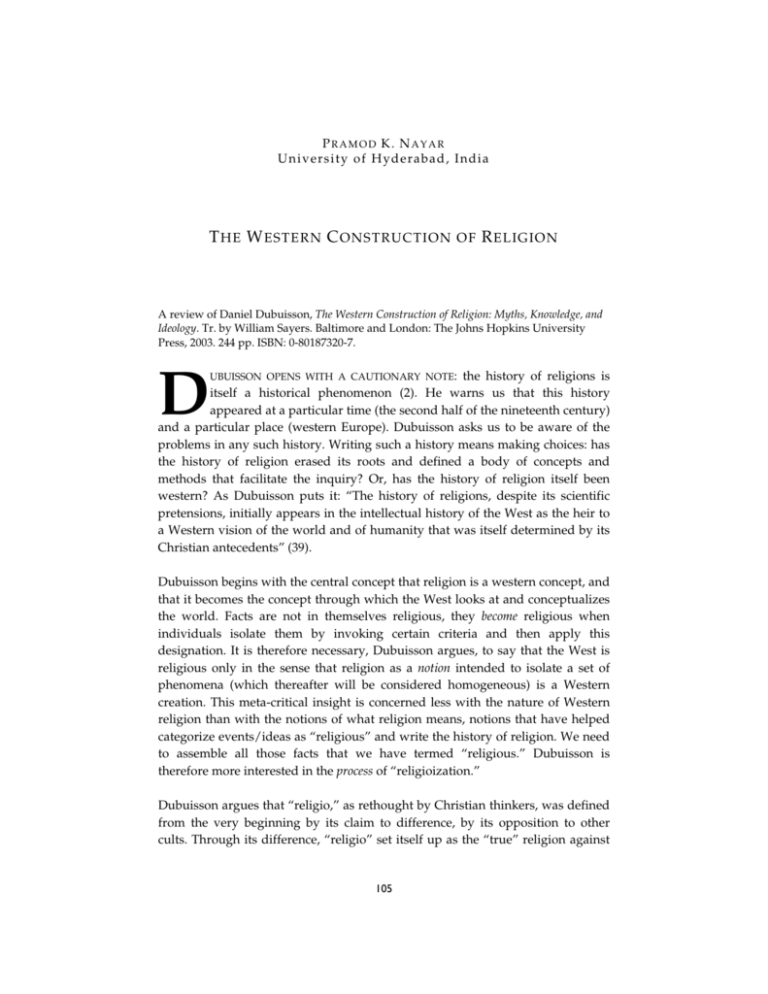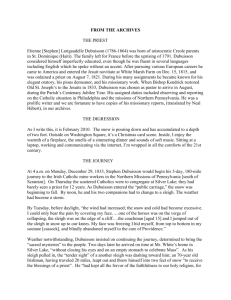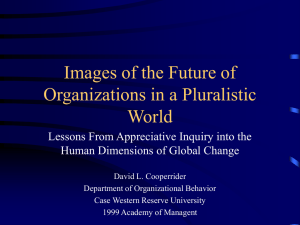
PRAMOD K. NAYAR
U ni ve rsi ty o f H yd era bad , I ndia
T HE W ESTERN C ONSTRUCTIO N O F R ELIG IO N
A review of Daniel Dubuisson, The Western Construction of Religion: Myths, Knowledge, and
Ideology. Tr. by William Sayers. Baltimore and London: The Johns Hopkins University
Press, 2003. 244 pp. ISBN: 0-80187320-7.
the history of religions is
itself a historical phenomenon (2). He warns us that this history
appeared at a particular time (the second half of the nineteenth century)
and a particular place (western Europe). Dubuisson asks us to be aware of the
problems in any such history. Writing such a history means making choices: has
the history of religion erased its roots and defined a body of concepts and
methods that facilitate the inquiry? Or, has the history of religion itself been
western? As Dubuisson puts it: “The history of religions, despite its scientific
pretensions, initially appears in the intellectual history of the West as the heir to
a Western vision of the world and of humanity that was itself determined by its
Christian antecedents” (39).
D
UBUISSON OPENS WITH A CAUTIONARY NOTE:
Dubuisson begins with the central concept that religion is a western concept, and
that it becomes the concept through which the West looks at and conceptualizes
the world. Facts are not in themselves religious, they become religious when
individuals isolate them by invoking certain criteria and then apply this
designation. It is therefore necessary, Dubuisson argues, to say that the West is
religious only in the sense that religion as a notion intended to isolate a set of
phenomena (which thereafter will be considered homogeneous) is a Western
creation. This meta-critical insight is concerned less with the nature of Western
religion than with the notions of what religion means, notions that have helped
categorize events/ideas as “religious” and write the history of religion. We need
to assemble all those facts that we have termed “religious.” Dubuisson is
therefore more interested in the process of “religioization.”
Dubuisson argues that “religio,” as rethought by Christian thinkers, was defined
from the very beginning by its claim to difference, by its opposition to other
cults. Through its difference, “religio” set itself up as the “true” religion against
105
NAYAR: Western Construction of Religion
106
paganism, atheism, heresy, etc. Dubuisson notes that the distinct domain of
religion does not exist in all civilizations – that the oppositions such as false
versus true religion are themselves Christian concepts. Finally, religion relies on
texts to find the coherence and homogeneity of religion. A group of scattered
texts are ordered into a corpus, which is then identified as the source of religious
ideas.
The subject of inquiry in the history of religion, Dubuisson notes, has often been
to discover a series of traits that is universally valid. But this means that the
Western definition of what “religious” means will have to be applied to nonWestern belief systems too. The second route of inquiry has been to replace the
Western notion of religion with that of cosmographic formations. This enables us
to look at the totality of human activities whose aim is the creation and
preservation of all-encompassing symbolic universes. It is this second mode that
Dubuisson favours.
After an exploration of the various definitions of religion, Dubuisson argues that
we need to respect the structural uniqueness of each cultural continuum, so that
comparison should not be at the price of what makes each unique. The reduction
of religion to a simplified schema – as has been done in the (Western) history of
religion – has meant that, in the search for universally valid “features,” the
uniqueness of cultural formations have been destroyed. Thus, when we speak of
Greek or Roman religion, we ignore the fact that Latin has no word to designate
religion. Dubuisson asks: “in the name of which scientific criteria has it been
decided that magic, divination, astrology, horoscopes, pharmacology, alchemy,
sorcery, and secret initiatory teachings do not belong to the religious sphere”
(73)? Western epistemology either includes them in its definition of religion, or
excludes them (while ignoring its own heritage of magic and spiritualism).
Taxonomies of religion function either at the level of binaries (true versus false,
revealed versus natural religions) or evolution (natural, artificial, animist
religions). Such taxonomies, Dubuisson demonstrates, are almost always
ethnocentrically prejudiced. All the academic work published in the field tends
to obey the principle of classification. Contemporary epistemology falls into two
categories: the fragment and the whole, great theories of religion on the one hand
(exemplified by Eliade’s work), and the monograph on the other. Any scientific
status of the study of religion is illusory, since it results from a “complex process
that mixes together trivial observations, deductions founded on our own
intellectual prejudices, and explicatory schemas borrowed from the most
narrowly positivist epistemologies” (91).
Exploring “Christianity and the West,” Dubuisson traces the evolution of the
JCRT 6.3 (Fall 2005)
NAYAR: Western Construction of Religion
107
very notion of a “true” religion through the processes of interiorization and
universalization. The first process individualized conscience. The second
postulated a generic human being, a “disincarnate idealization of an impersonal
being” (110). This postulate ignored “various cultural, ethnic, and social points of
reference” (Ibid). Epistemology, Dubuisson shows, moved from Christian
universalism to the universalism of science. The movement begun by Saint Paul
to evangelize pagans and to address oneself to all human beings was echoed in
the movement of Western science, in the attitude that universalized those
categories and values which issued from Western culture alone.
Dubuisson notes that a “vast general topic” (117) has been built around the
nucleus of religion. The ideas and general positions that thematized access to
reality were themselves inventoried. The general topic contains schema that
define the loci from which the interpreter or historian speaks; it provides a
hermeneutical scheme. Dubuisson provides an inventory of the topic around
which the field of the history of religions has been organized: true religion versus
false religion, theism versus materialism and atheism, revealed religion versus
natural religion.
Turning to the history of religions, Dubuisson reiterates his central argument:
“the history of religions … reveals itself to be not only a Western discipline but a
science born of the closing decades of the nineteenth century” (155). Even in the
twentieth century, Dubuisson suggests, all explanations (as to why
cultures/societies produce religion) that claim to be scientific finally “reduce the
infinite variety of reality to a principle or to a unique, ontologically
homogeneous cause.” They are nothing less than “real acts of metaphysical
aggression” (167). The influential thesis of Homo religious is, Dubuisson argues,
a derivation from a mythic imagination, but the elements are themselves the
result of an ideological development.
Pleading for the substitution of the notion of religion with that of “cosmographic
formation,” Dubuisson outlines his three main objectives:
To determine a general concept capable of encompassing the heterogeneous
totality of those facts and notions that are currently excluded from the totality
that we call “religion” on the basis of Christian theological criteria;
To stimulate contemporary anthropological thought to concern itself with the
human condition;
To make obsolete the majority of the debates and categorizations that the history
of religions conserves and defends (199-200).
JCRT 6.3 (Fall 2005)
NAYAR: Western Construction of Religion
108
Dubuisson leaves us with certain axioms that (can) function as new ways of
reading religion, faith and cultural practices: every cosmographical formation is
a world, its own world; all cultures are thereby similar and all are different; the
worlds created by human beings are metaphysical worlds; each world is a
totality, but contingent, unique and autonomous; belonging to a world itself
assumes the form of a world; every world of this kind is a common world in
which people live and age together; each world contains our texts, our lives, and
our bodies (201).
Dubuisson’s work is a Foucauldian exploration of the epistemes that have
constructed classificatory grids to slot cultural systems. These grids, Dubuisson
demonstrates, proceed from a mythic imagination but take on the character of
scientific/objective inquiry. Dubuisson’s attention to the rhetorical construction
of religion enables him to critique the discourse of religiosity itself, a discourse
that he conclusively demonstrates to be Western. Although it is a rigorous
inquiry into the systems of thought and the history of ideas, The Western
Construction of Religion may have benefited from a closer examination into the
politics of the dissemination of religion and faith-systems. The debate around
secularism or “state-religion” that figures prominently in several countries across
the world has a lot to with contemporary geopolitics and is informed by
economics and the military rather than by shared cultural beliefs. Thus, an
inquiry into the colonial, racial, capitalist and military contexts of the notions of
religion – especially in the 20th century – would have added another dimension
to what is already a thoughtful book.
PRAMOD K. NAYAR teaches at the Dept. of English, University of Hyderabad, India. His
recent work includes Literary Theory Today (2002), Virtual Worlds: Culture and Politics in the
Age of Cybertechnology (2004) besides essays on English travel writing on India.
©2005 Pramod K. Nayar. All rights reserved.
Nayar, Pramod K. “The Western Construction of Religion.” Journal for Cultural and Religious Theory
vol. 6 no. 3 (Fall 2005): 105-108.
PURL: http://www.jcrt.org/archives/06.3/nayar.pdf
JCRT 6.3 (Fall 2005)










